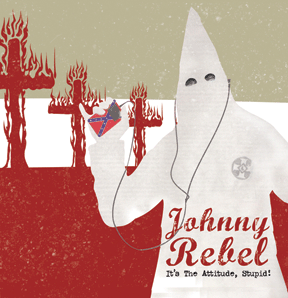
(
UBM: Before this week was over, I had to cross the tracks and get a white guy’s input for Funky Whiteboy Appreciation Week. So let me pass the mic to New Orleans musician Davis Rogan, who recently turned me on to the French band Ceux Qui Marchent Debout.)
In the summer of 2001, I went on a European tour with a pickup group from New Orleans I’ll call “The Drunk And Irresponsible Brass Band.”
In the midst of some John Bohnamesque antics somewhere in Switzerland, the group decided they could keep from getting kicked off the festival circuit by firing the white boy – me. Their efforts proved futile, though, as their bitch asses got sent home the next week.
So I ended up in Paris, homeless and relatively penniless, at the mercy of Ceux Qui Marchent Debout, a funky Parisian brass band that had opened for my brass funk outfit, All That, at JazzFest and blown our asses off the stage.

They adopted me. Their friends ran the greatest restaurant in Paris; they owned a bar where I couldn’t pay for a drink; the trombone player gave me the keys to his apartment, jumped into his VW bus with his ridiculously hot girlfriend and said “See you at the shows.”
The band learned three of my tunes and took me all over France that summer as a guest vocalist.
Those feats alone could win pretty much any group my Favorite-Band-in-the-World status. But Ceux Qui Marchent Debout – or CQMD – gets the trophy simply for being a fucking great band. Really great. Really funky.
The revolution started by the Dirty Dozen and Rebirth brass bands was a shot heard ’round the world. The Dozen’s
Kirk Joseph took the sousaphone (John Philip’s wrap-around marching version of the tuba), gave up on the corny oom-pah bag and started playing it like a bass.
The Dozen added R&B tunes and bebop chops into the brass band. The Rebirth added youthful fire and boom on the drums. No brass band in New Orleans – or on planet Earth – has sounded the same since.
France has its own tradition of the marching brass band, or
groupe de fanfare. The students at the art school in Paris get naked and march through the streets of Paris blowing horns.
CQMD came out of art school, just like
Monday’s funky white kids, the Talking Heads. David Byrne is a fan, and a CQMD track appears on one of his Luaka Bop world music
compilations.

I cornered David Byrne at a cocktail party once, and my entrée was our association with this group. “Ceux Qui Marchent Debout is a great live band,” he said.
It’s easy enough to send a packed house of tripping trustafarians into ecstasy, like they did at Tipitina’s in New Orleans. And the 15,000 people they wowed at Festival Acadien... well, that’s a bunch of Cajuns, they come to party.
But what I’ve witnessed is CQMD at some little microfestival in the middle of bumfuck Loire Valley, playing for a bunch of reserved, anal, old, straight-up honky French motherfuckers and making those geezers freak the fuck out.
So David Byrne is right, CQMD is a great live band. But they also make some great records.
While so many bands influenced by New Orleans are limited to a New Orleans groove, and so many foreigners (too often the Japanese) are able to study and regurgitate jazz or brass band music, CQMD actually manages to nod to all these traditions – and to ’70s funk and reggae and rap – and come back atcha with some original shit.
CQMD’s 1995 album
“Debout” opens with snare drummer Tafani kicking a hilarious rap, in French, about the joys of eating mayonnaise. Their second record, the tragically out-of-print “Your Boddy,” begins with a straight up Chuck Brown go-go groove, the whole band chanting “Get your ass in the bus – and don’t you make no fuss.”
Their third album,
“La La Lalalala,” is an amazing recording alone because they recorded the whole thing live, straight to mini disc with one stereo microphone, and it’s just as dense and complex as their studio shit. That comes from these guys being so ridiculously incredibly tight.
Click here to hear “Free Orange Louisiana.”

(One of CQMD’s distinguishing variations on the brass band lineup is a banjo. Fuck that straw-hat Dixieland shit, I mean a
funky banjo... straight-outta-Fela, chicken-scratchin’ banjo. That’s Clark.)
CQMD’s fourth disc, all covers, reveals how deep the band’s vinyl collection runs. “Funky Stuff in a Reggae Style” presents reggae reinterpretations of the funk canon, from P-Funk to Chocolate Milk.
Click here to hear “One Nation Under a Groove.”
This album and the band’s next two feature a lithe, sexy French- Algerian singer named
Ounsa, who has since gone solo.
I confess I haven’t much heard CQMD’s 2008 release, “Check That Funk.” But sitting down to write this piece, and listening again to all these great records... it’s enough to make me buy an international calling card and harass these cats for my free shit.
– Davis Rogan
 1. “Manic Depression” – Buddy Miles
1. “Manic Depression” – Buddy Miles











































